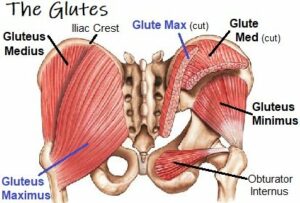A pain in the butt? Strikingly, pain on the outside of the hip affects 1 in 4 women between the ages of 50 and 70 and is most prevalent in menopausal women as the levels of oestrogen change. These stats are representative of what we treat in the clinic in this population every day.
Gluteal tendonitis or the more accurate terminology is Gluteal Tendinopathy, is a condition characterized by pain located on the outside of the hip and buttock. These tendons are responsible for connecting the gluteal muscles to the hip and pelvis, and when they become inflamed, it can result in pain and discomfort in the buttocks and hip area. The bursa may also be involved.
Causes: Gluteal tendonitis can be caused by a variety of factors, such as overuse of the gluteal muscles, poor biomechanics, muscle imbalances. It can also occur as a result of trauma or injury to the hip or buttocks. Sometimes, a change in activity such as commencing running can trigger the onset of symptoms.
Symptoms: Common symptoms of gluteal tendonitis include pain and tenderness in the buttocks, especially when sitting or lying on the affected side. Credit to Tom Goom (aka the Running Physio, please do visit his website for a host of great resources www.https://www.running-physio.com/) for this lovely visual representation of the site of symptoms frequently reported. There may also be pain with activities such as walking, climbing stairs, or standing from a seated position. In some cases, there may be swelling or a feeling of weakness in the hip or buttocks.
Diagnosis: It is important that your physiotherapy carry out a thorough assessment to identify which structure is the culprit. There are lots of structures on the outside of the hip that have a large quantity of nerve endings such as the gluteal tendons, the ITB and the bursa. But the picture could be blurred by including an underlying hip joint issue or nearby nerves. An accurate diagnosis with a physiotherapist will determine this and then will be able to prescribe the best treatment too.
Treatment: Treatment for gluteal tendonitis typically involves a combination of advice and education on the Do’s and Don’ts, specific targeted exercise to improve the capacity of the tendons. Where there is a joint involvement, then a different treatment will be ensue.
Physiotherapy is the mainstay treatment for this hip pain. There are many scientific studies demonstrating the effectiveness of graded exercise prescription. Nowadays, corticosteroid injections are rarely used as they have been found to have only temporary effects with physiotherapy being 20% more effective than injection therapy alone.
In summary, if you are suffering with a pain in your butt, let our team of brilliant physiotherapists help you by establishing an accurate diagnosis and treatment plan. Book now

